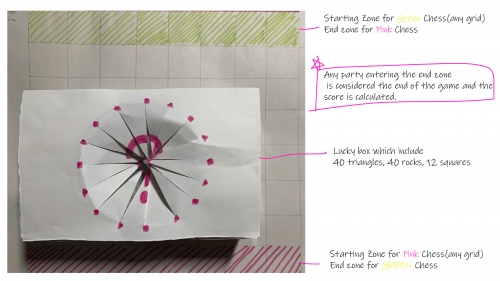THEME
Play and Force
CONTEXT
In terms of this week's theme. I want to make a card game basic on a simple rule which connects two equilateral triangles to get a square. This is a very simple common sense that everyone can recognize, but it is worth my exploration to develop a simple logic into a playable card game.
In my understanding, the Force can be understood as a rule, and it is sometimes easier to develop an idea under limited circumstances than under boundless conditions. While thinking about the logic and rules of the game, I also set the concept that luck is also a force. Just like when playing Monopoly, shrewd real estate investment ability is sometimes not more useful than being able to roll lucky dice.
METHOD
card game:Triangle and Square
I first set up the basic rules. There are three different patterns of cards in the lucky box.
They are triangles, squares, and stones. If two triangles are in the right direction, they will be connected to a square.
Scoring rules: 1 point for triangles, 5 points for squares, and 0 points for stones.
In order to realize the principle of Luck is a force. It is impossible to foresee the next card during the game.
Moreover, in the lucky box, there are 40 triangles, 40 stones, and 12 squares. This is also set up to make players not only try to get as many points as possible but also have good luck during the game.
Next, I drew a checkered chessboard of 8 by 8. I followed the basic rules set at the beginning to test the direction of this game and specific play methods. I can only continue to design the game when I am restricted and improve the logic and playability of the game.
Eventually, I play through a variety of practical ways, summed up a complete set of rules of the game.
RESPONSE
In summary, I made a card game.
It has two modes, single-player mode and two-player battle mode. Due to the lock-down period, I can only test the single-player mode by myself.
The rules of the game are as follows:
Choose a colour and start the game on a board of 8 times 8. The row of grids closest to you is the starting zone. Players can choose any grid to start their first step. All chess cards need to be drawn randomly from the lucky box.
When the player draws a triangle, he needs to consider the direction the triangle is facing. Only the two cards on the opposite side of the triangle row can be connected to form a square. If you draw a square, you don’t need to worry about the direction. There is also a non-scoring stone card in the lucky box. All scores are calculated uniformly at the end of the game.
Action rules: In both modes, players can only follow the cross grid area of the latest card. If the cross grid area cannot continue, the game is deemed to be over.
Scoring rules: 1 point for triangles, 5 points for squares, and 0 points for stones. (After the game is over, all triangles on the field that can be connected to form a square will be counted in the total score)
Win conditions: When any card reaches the end zone, it is considered the end of the game and all points on the field can be calculated. (In the two-player battle mode, the game is over when either party reaches the end zone.) The player with the highest score wins.
This is my first attempt to design a card game by myself. So the selection rules are relatively simple. In this practice, I think the design of the game is a process of constant debugging in the rules. These rules became the framework of the game. During the course, I also understood that the concept of force is very broad, and rules are just one expression. But rules can also be understood as the basis of Force. For example, sound and wind are experimented based on the rules of nature or physics. In the process of individual testing, I very much hope to be able to test the two-player battle mode, hoping to experience with peers later.
About This Work
By Shika X
Email Shika X
Published On: 16/09/2020



